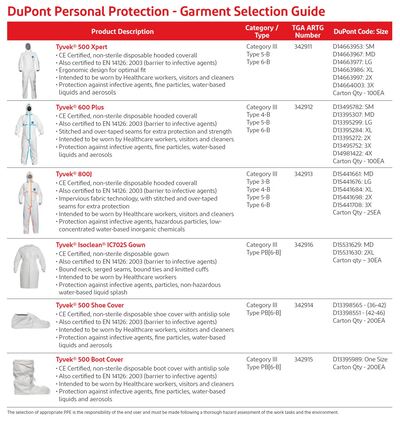Coronaviruses — protective apparel selection

What are coronaviruses?
Coronaviruses are a large family of viruses that can cause diseases ranging from the common cold to more severe illnesses such as Severe Acute Respiratory Syndrome (SARS) and Middle East Respiratory Syndrome (MERS). The SARS-associated coronavirus (SARS-CoV) was recognised in China as early as November 2002. The 2019 disease outbreak in China has been attributed to a coronavirus referred to as 2019-nCoV.
Coronaviruses affect the respiratory system, typically resulting in severe acute respiratory illness displaying symptoms of fever, malaise, cough and shortness of breath. About 30–40% of patients reported with MERS have died during previous outbreaks of the disease.1
How is a coronavirus spread?
The majority of human cases of coronavirus illness have been attributed to human-to-human infections. Coronaviruses are believed to spread from an infected person’s respiratory secretions, although the specific ways the virus spreads are not currently well understood. These viruses spread from sick people to others through close contact, such as unprotected caring for or living with an infected person. Infected people also are known to have spread coronaviruses to others in healthcare settings.
Who needs to be protected?
Based on experience with SARS and MERS outbreaks, transmission of coronaviruses has occurred in healthcare facilities around the world, including from patients to healthcare providers and between patients in a healthcare setting before the virus was diagnosed. The symptoms and other clinical features of coronavirus illness are non-specific, making it difficult to identify infected patients early or without testing.
Infection prevention and control measures are critical to prevent the spread of coronavirus illness in healthcare facilities or other workplaces, such as airports, where infected but undetected people may be present. Healthcare and other at-risk workers should be educated and trained in infection prevention and control and be diligent in practising these safety measures.
What protective apparel is available?
The Centers for Disease Control (CDC) and World Health Organization (WHO) provide direction on infection prevention and control procedures related to 2019-nCoV, SARS-CoV, MERS-CoV and other coronaviruses. They provide guidance to healthcare professionals for the use of personal protective equipment (PPE) for contact with patients with known or suspected cases of coronavirus infections. Both suggest the use of clean, disposable, long-sleeved garments.
For a clearer image, click here.
DuPont Personal Protection provides a wide range of protective garments and accessories that address a broad range of PPE needs. DuPont’s web-based tool SafeSPEC can assist with finding the appropriate garments for chemical, controlled environment, thermal, and mechanical hazards.
Reference
1. CDC Fact Sheet, Information about Middle East Respiratory Syndrome (MERS).
Helping to keep health care professionals hands-on
Aqium Gel is a Registered Medicine (AUST R 179333) hand sanitiser formulated with 70 percent w/w...
Keeping Infection Prevention Front of Mind – Every Day of the Year
Infection prevention is an ongoing commitment to safer care. Every day, healthcare professionals...
The Challenge of Biofilms in Healthcare
Biofilms represent a formidable challenge in the ongoing battle against healthcare-associated...





![[New Zealand] Transform from Security Awareness to a Security Culture: A Vital Shift for SMB Healthcare — Webinar](https://d1v1e13ebw3o15.cloudfront.net/data/89856/wfmedia_thumb/..jpg)
![[Australia] Transform from Security Awareness to a Security Culture: A Vital Shift for SMB Healthcare — Webinar](https://d1v1e13ebw3o15.cloudfront.net/data/89855/wfmedia_thumb/..jpg)




